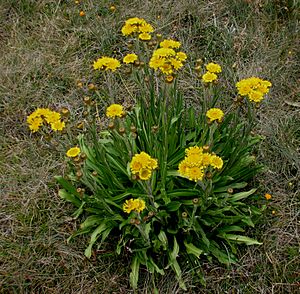Alpine podolepis facts for kids
Quick facts for kids Alpine podolepis |
|
|---|---|
 |
|
| Podolepis robusta Alpine National Park, Victoria |
|
| Scientific classification | |
| Kingdom: | |
| (unranked): | |
| (unranked): | |
| (unranked): | |
| Order: | |
| Family: | |
| Genus: |
Podolepis
|
| Species: |
P. robusta
|
| Binomial name | |
| Podolepis robusta (Maiden & Betche) J.H.Willis
|
|
| Synonyms | |
|
Podolepis longipedata var. robusta Maiden & Betche |
|
Podolepis robusta, also known as Alpine Podolepis, Mountain Lettuce, or Cattleman's Lettuce, is a plant that lives for many years. It belongs to the Asteraceae family, which includes daisies. This plant grows in the Australian Alps.
About Alpine Podolepis
This plant has a thick, straight stem that can grow up to 60 centimeters (about 2 feet) tall. In summer, it produces bright yellow flower heads. These flower heads are about 25 millimeters (1 inch) wide.
The leaves at the bottom of the plant are spoon-shaped and can be up to 20 centimeters (8 inches) long. They wrap around the stem. Higher up on the stem, the leaves become smaller.
Where Does It Grow?
You can find Podolepis robusta in the grassy areas of the Australian Alps. It often grows near snow gum trees. Its home range stretches south from Mount Gingera in the Australian Capital Territory.
How It Got Its Name
Scientists first described this plant in 1898. They called it Podolepis longipedata var. robusta. This name came from plants found on Mount Kosciuszko, Australia's highest mountain.
Later, in 1942, a botanist named Jim Willis gave it a new name: Podolepis acuminata var. robusta. Then, in 1954, he decided it was unique enough to be its own species. So, he officially named it Podolepis robusta.

